Simulations of Organic Aerosol with CAMx over the Po Valley during the Summer Season
Abstract
1. Introduction
2. Materials and Methods
2.1. Model Setup
2.2. Model Performance Evaluation
3. Results
3.1. Overall Model Validation
3.2. Organic Aerosol Reproduction
3.2.1. Ispra Site
3.2.2. Bologna Site
4. Discussion
- The changes in IVOC emissions only concern anthropogenic sources (road traffic and biomass combustion), but the effects of those relating to biomass combustion are counterbalanced by the significant reduction in the activity of this source in the warm season;
- In the warm season, SOA of biogenic origin contribute much more significantly to the overall mass of SOA, thus masking the effect of the increased anthropogenic emissions;
- Warm season conditions, namely, ambient temperature, favor the partitioning of organic compounds in the vapor phase rather than in the particulate one, contributing to further limiting the effect of the increased IVOC emissions on aerosol production.
5. Conclusions
Supplementary Materials
Author Contributions
Funding
Institutional Review Board Statement
Informed Consent Statement
Data Availability Statement
Conflicts of Interest
References
- Targa, J.; Ripoll, A.; Banyuls, L.; González, A.; Soares, J. Status Report of Air Quality in Europe for Year 2020, Using Validated Data (Eionet Report—ETC/HE 2022/2). 2022. Available online: https://www.eionet.europa.eu/etcs/etc-he/products/etc-he-products/etc-he-reports/etc-he-report-2022-2-status-report-of-air-quality-in-europe-for-year-2020-using-validated-data (accessed on 6 November 2022).
- Nault, B.A.; Jo, D.S.; McDonald, B.C.; Campuzano-Jost, P.; Day, D.A.; Hu, W.; Schroder, J.C.; Allan, J.; Blake, D.R.; Canagaratna, M.R.; et al. Secondary organic aerosols from anthropogenic volatile organic compounds contribute substantially to air pollution mortality. Atmos. Chem. Phys. 2021, 21, 11201–11224. [Google Scholar] [CrossRef]
- Chang, X.; Zhao, B.; Zheng, H.; Wang, S.; Cai, S.; Guo, F.; Gui, P.; Huang, G.; Wu, D.; Han, L.; et al. Full-volatility emission framework corrects missing and underestimated secondary organic aerosol sources. One Earth 2022, 5, 403–412. [Google Scholar] [CrossRef]
- Patoulias, D.; Kallitsis, E.; Posner, L.; Pandis, S.N. Modeling Biomass Burning Organic Aerosol Atmospheric Evolution and Chemical Aging. Atmosphere 2021, 12, 1638. [Google Scholar] [CrossRef]
- Bergström, R.; van der Gon, H.A.C.D.; Prévôt, A.S.H.; Yttri, K.E.; Simpson, D. Modelling of organic aerosols over Europe (2002–2007) using a volatility basis set (VBS) framework: Application of different assumptions regarding the formation of secondary organic aerosol. Atmos. Chem. Phys. 2012, 12, 8499–8527. [Google Scholar] [CrossRef]
- Woody, M.C.; Baker, K.R.; Hayes, P.L.; Jimenez, J.L.; Koo, B.; Pye, H.O.T. Understanding sources of organic aerosol during CalNex-2010 using the CMAQ-VBS. Atmos. Chem. Phys. 2016, 16, 4081–4100. [Google Scholar] [CrossRef]
- Hodzic, A.; Jimenez, J.L.; Madronich, S.; Aiken, A.C.; Bessagnet, B.; Curci, G.; Fast, J.; Lamarque, J.-F.; Onasch, T.B.; Roux, G.; et al. Modeling organic aerosols during MILAGRO: Importance of biogenic secondary organic aerosols. Atmos. Chem. Phys. 2009, 9, 6949–6981. [Google Scholar] [CrossRef]
- Donahue, N.M.; Epstein, S.A.; Pandis, S.N.; Robinson, A.L. A two-dimensional volatility basis set—Part 1: Organic-aerosol mixing thermodynamics. Atmos. Chem. Phys. 2011, 11, 3303–3318. [Google Scholar] [CrossRef]
- Donahue, N.M.; Kroll, J.H.; Pandis, S.N.; Robinson, A.L. A two-dimensional volatility basis set—Part 2: Diagnostics of organic-aerosol evolution. Atmos. Chem. Phys. 2012, 12, 615–634. [Google Scholar] [CrossRef]
- Huang, L.; Wang, Q.; Wang, Y.; Emery, C.; Zhu, A.; Zhu, Y.; Yin, S.; Yarwood, G.; Zhang, K.; Li, L. Simulation of secondary organic aerosol over the Yangtze River Delta region: The impacts from the emissions of intermediate volatility organic compounds and the SOA modeling framework. Atmos. Environ. 2020, 246, 118079. [Google Scholar] [CrossRef]
- Ots, R.; Young, D.E.; Vieno, M.; Xu, L.; Dunmore, R.E.; Allan, J.D.; Coe, H.; Williams, L.R.; Herndon, S.C.; Ng, N.L.; et al. Simulating secondary organic aerosol from missing diesel-related intermediate-volatility organic compound emissions during the Clean Air for London (ClearfLo) campaign. Atmos. Chem. Phys. 2016, 16, 6453–6473. [Google Scholar] [CrossRef]
- Dunmore, R.E.; Hopkins, J.R.; Lidster, R.T.; Lee, J.D.; Evans, M.J.; Rickard, A.R.; Lewis, A.C.; Hamilton, J.F. Diesel-related hydrocarbons can dominate gas phase reactive carbon in megacities. Atmos. Chem. Phys. 2015, 15, 9983–9996. [Google Scholar] [CrossRef]
- Giani, P.; Balzarini, A.; Pirovano, G.; Gilardoni, S.; Paglione, M.; Colombi, C.; Gianelle, V.L.; Belis, C.A.; Poluzzi, V.; Lonati, G. Influence of semi- and intermediate-volatile organic compounds (S/IVOC) parameterizations, volatility distributions and aging schemes on organic aerosol modelling in winter conditions. Atmos. Environ. 2019, 213, 11–24. [Google Scholar] [CrossRef]
- Ciarelli, G.; El Haddad, I.; Bruns, E.; Aksoyoglu, S.; Möhler, O.; Baltensperger, U.; Prévôt, A.S.H. Constraining a hybrid volatility basis-set model for aging of wood-burning emissions using smog chamber experiments: A box-model study based on the VBS scheme of the CAMx model (v5.40). Geosci. Model Dev. 2017, 10, 2303–2320. [Google Scholar] [CrossRef]
- Zhao, Y.; Nguyen, N.T.; Presto, A.A.; Hennigan, C.J.; May, A.A.; Robinson, A.L. Intermediate Volatility Organic Compound Emissions from On-Road Diesel Vehicles: Chemical Composition, Emission Factors, and Estimated Secondary Organic Aerosol Production. Environ. Sci. Technol. 2015, 49, 11516–11526. [Google Scholar] [CrossRef] [PubMed]
- Zhao, Y.; Nguyen, N.T.; Presto, A.A.; Hennigan, C.J.; May, A.A.; Robinson, A.L. Intermediate volatility organic compound emissions from on-road gasoline vehicles: Chemical composition, emission factors, and estimated secondary organic aerosol production. Environ. Sci. Technol. 2016, 50, 4554–4563. [Google Scholar] [CrossRef] [PubMed]
- Denier van der Gon, H.A.C.; Bergström, R.; Fountoukis, C.; Johansson, C.; Pandis, S.N.; Simpson, D.; Visschedijk, A.J.H. Particulate emissions from residential wood combustion in Europe—Revised estimates and an evaluation. Atmos. Chem. Phys. 2015, 15, 6503–6519. [Google Scholar] [CrossRef]
- ENVIRON. CAMx (Comprehensive Air Quality Model with Extensions) User’s Guide, Version 6.40; ENVIRON International Corporation: Novato, CA, USA, 2016. [Google Scholar]
- Meroni, A.; Pirovano, G.; Gilardoni, S.; Lonati, G.; Colombi, C.; Gianelle, V.; Paglione, M.; Poluzzi, V.; Riva, G.; Toppetti, A. Investigating the role of chemical and physical processes on organic aerosol modelling with CAMx in the Po Valley during a winter episode. Atmos. Environ. 2017, 171, 126–142. [Google Scholar] [CrossRef]
- Skamarock, W.C.; Klemp, J.B.; Dudhia, J.; Gill, D.O.; Barker, D.M.; Duda, M.G.; Huang, X.-Y.; Wang, W.; Powers, J.G. A Description of the Advanced Research WRF; Version 3; NCAR Technical Note -475+STR; University Corporation for Atmospheric Research: Boulder, CO, USA, 2008. [Google Scholar] [CrossRef]
- UNC—University of North Carolina, Institute for the Environment. SMOKE v3.5 User’s Manual. Chapel Hill. 2013. Available online: https://www.cmascenter.org/smoke/ (accessed on 6 November 2022).
- ISPRA Italian National Inventory Data. Available online: http://emissioni.sina.isprambiente.it/inventario-nazionale/ (accessed on 6 November 2022).
- INEMAR—ARPA Lombardia. Emission Inventory: 2012 Emission in Region Lombardy—Public Review. ARPA Lombardia Settore Aria. 2015. Available online: http://www.inemar.eu/ (accessed on 6 November 2022).
- Guenther, A.; Karl, T.; Harley, P.; Wiedinmyer, C.; Palmer, P.I.; Geron, C. Estimates of global terrestrial isoprene emissions using MEGAN (Model of Emissions of Gases and Aerosols from Nature). Atmos. Chem. Phys. 2006, 6, 3181–3210. [Google Scholar] [CrossRef]
- Gong, S.L. A parameterization of sea-salt aerosol source function for sub- and super-micron particles. Glob. Biogeochem. Cycles 2003, 17, 1097. [Google Scholar] [CrossRef]
- Strader, R.; Lurmann, F.; Pandis, S.N. Evaluation of secondary organic aerosol formation in winter. Atmos. Environ. 1999, 33, 4849–4863. [Google Scholar] [CrossRef]
- Koo, B.; Knipping, E.; Yarwood, G. 1.5-Dimensional volatility basis set approach for modeling organic aerosol in CAMx and CMAQ. Atmos. Environ. 2014, 95, 158–164. [Google Scholar] [CrossRef]
- Fountoukis, C.; Megaritis, A.G.; Skyllakou, K.; Charalampidis, P.E.; van der Gon, H.A.C.D.; Crippa, M.; Prévôt, A.S.H.; Fachinger, F.; Wiedensohler, A.; Pilinis, C.; et al. Simulating the formation of carbonaceous aerosol in a European Megacity (Paris) during the MEGAPOLI summer and winter campaigns. Atmos. Chem. Phys. 2016, 16, 3727–3741. [Google Scholar] [CrossRef]
- Robinson, A.L.; Donahue, N.M.; Shrivastava, M.K.; Weitkamp, E.A.; Sage, A.M.; Grieshop, A.P.; Lane, T.E.; Pierce, J.R.; Pandis, S.N. Rethinking Organic Aerosols: Semivolatile Emissions and Photochemical Aging. Science 2007, 315, 1259–1262. [Google Scholar] [CrossRef] [PubMed]
- Tsimpidi, A.P.; Karydis, V.A.; Zavala, M.; Lei, W.; Molina, L.; Ulbrich, I.M.; Jimenez, J.L.; Pandis, S.N. Evaluation of the volatility basis-set approach for the simulation of organic aerosol formation in the Mexico City metropolitan area. Atmos. Chem. Phys. 2010, 10, 525–546. [Google Scholar] [CrossRef]
- May, A.A.; Levin, E.J.T.; Hennigan, C.J.; Riipinen, I.; Lee, T.; Collett, J.L.; Jimenez, J.L.; Kreidenweis, S.M.; Robinson, A.L. Gas-particle partitioning of primary organic aerosol emissions: 3. Biomass burning. J. Geophys. Res. Atmos. 2013, 118, 11327–11338. [Google Scholar] [CrossRef]
- Pernigotti, D.; Thunis, P.; Cuvelier, C.; Georgieva, E.; Gsella, A.; De Meij, A.; Pirovano, G.; Balzarini, A.; Riva, G.M.; Carnevale, C.; et al. POMI: A model inter-comparison exercise over the Po Valley. Air Qual. Atmos. Health 2013, 6, 701–715. [Google Scholar] [CrossRef]
- Bressi, M.; Cavalli, F.; Belis, C.A.; Putaud, J.-P.; Fröhlich, R.; dos Santos, S.M.; Petralia, E.; Prévôt, A.S.H.; Berico, M.; Malaguti, A.; et al. Variations in the chemical composition of the submicron aerosol and in the sources of the organic fraction at a regional background site of the Po Valley (Italy). Atmos. Chem. Phys. 2016, 16, 12875–12896. [Google Scholar] [CrossRef]
- Gilardoni, S.; Massoli, P.; Paglione, M.; Giulianelli, L.; Carbone, C.; Rinaldi, M.; Decesari, S.; Sandrini, S.; Costabile, F.; Gobbi, G.P.; et al. Direct observation of aqueous secondary organic aerosol from biomass-burning emissions. Proc. Natl. Acad. Sci. USA 2016, 113, 10013–10018. [Google Scholar] [CrossRef]
- Paglione, M.; Gilardoni, S.; Rinaldi, M.; Decesari, S.; Zanca, N.; Sandrini, S.; Giulianelli, L.; Bacco, D.; Ferrari, S.; Poluzzi, V.; et al. The impact of biomass burning and aqueous-phase processing on air quality: A multi-year source apportionment study in the Po Valley, Italy. Atmos. Chem. Phys. 2020, 20, 1233–1254. [Google Scholar] [CrossRef]

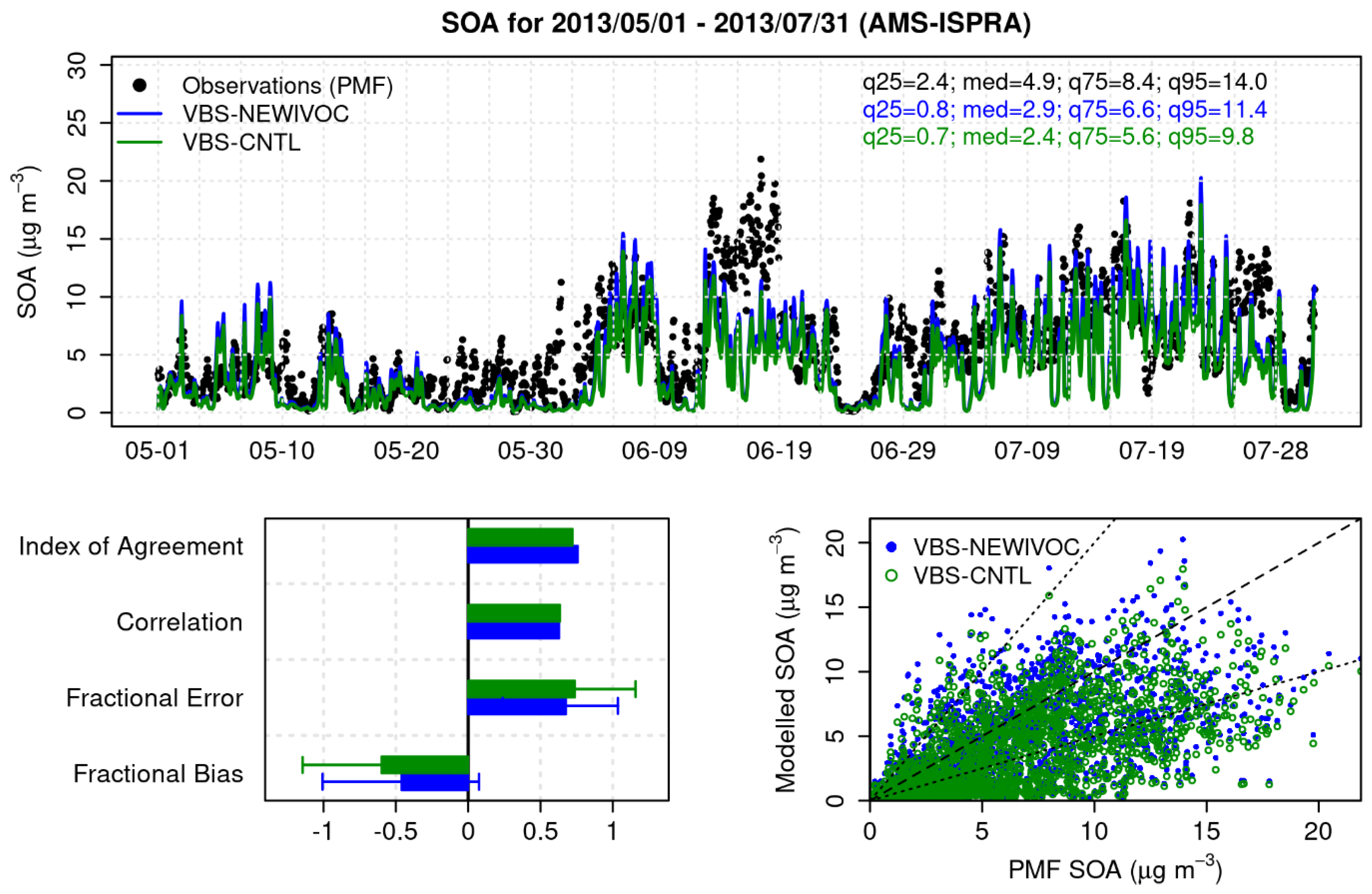

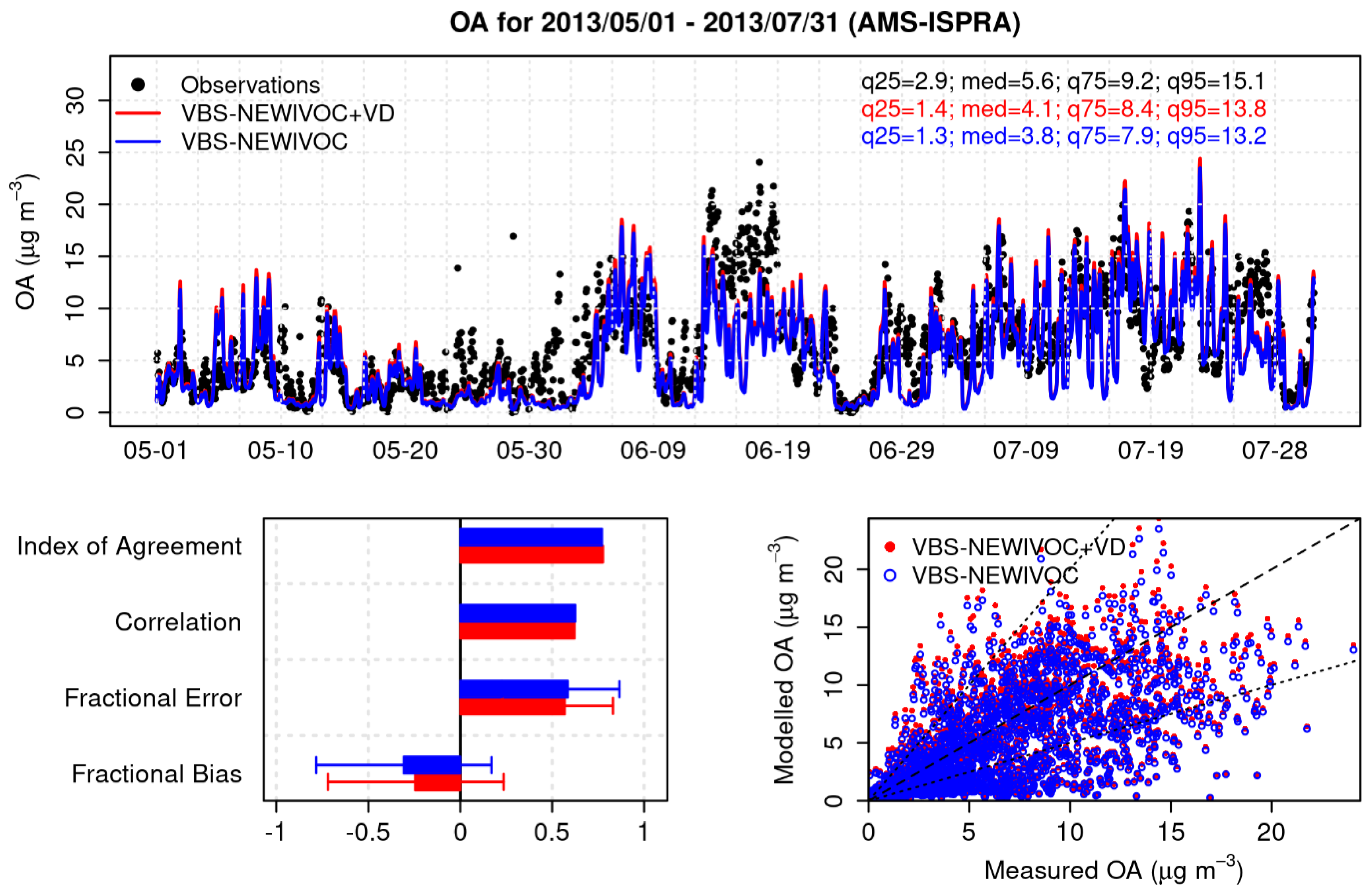


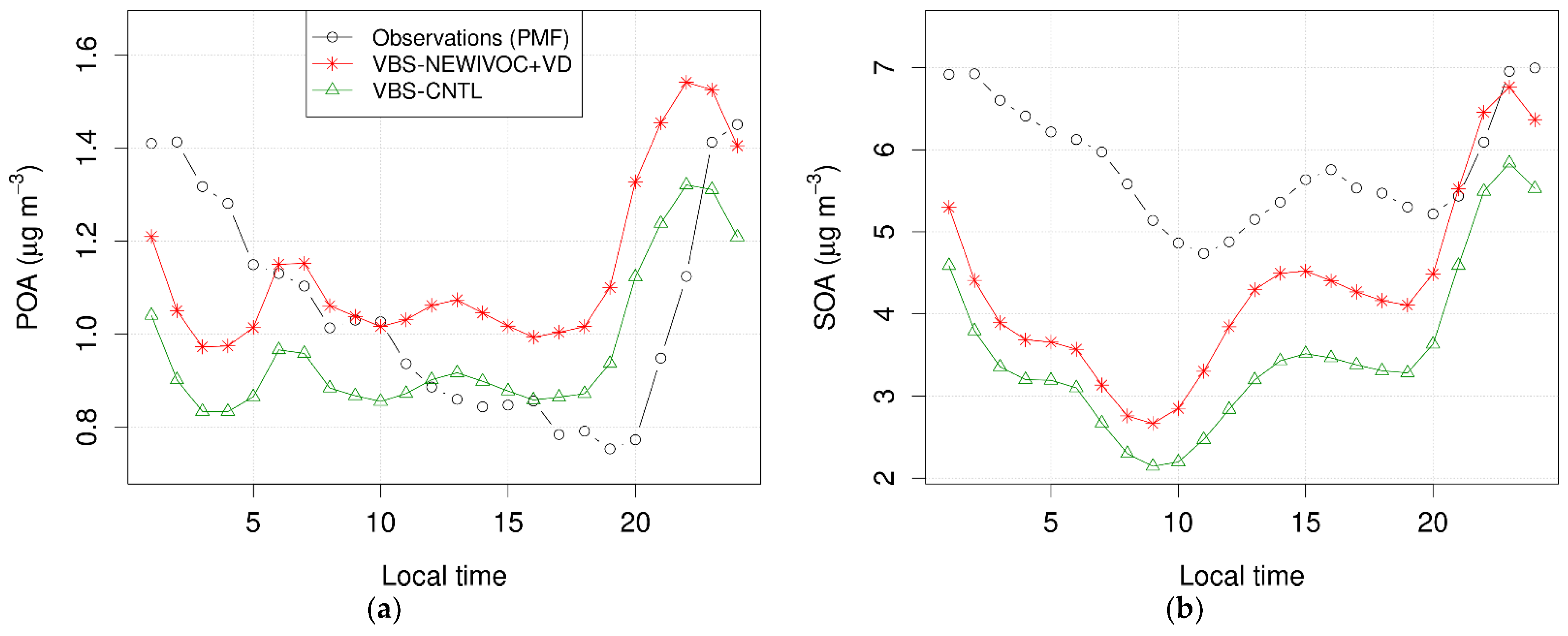

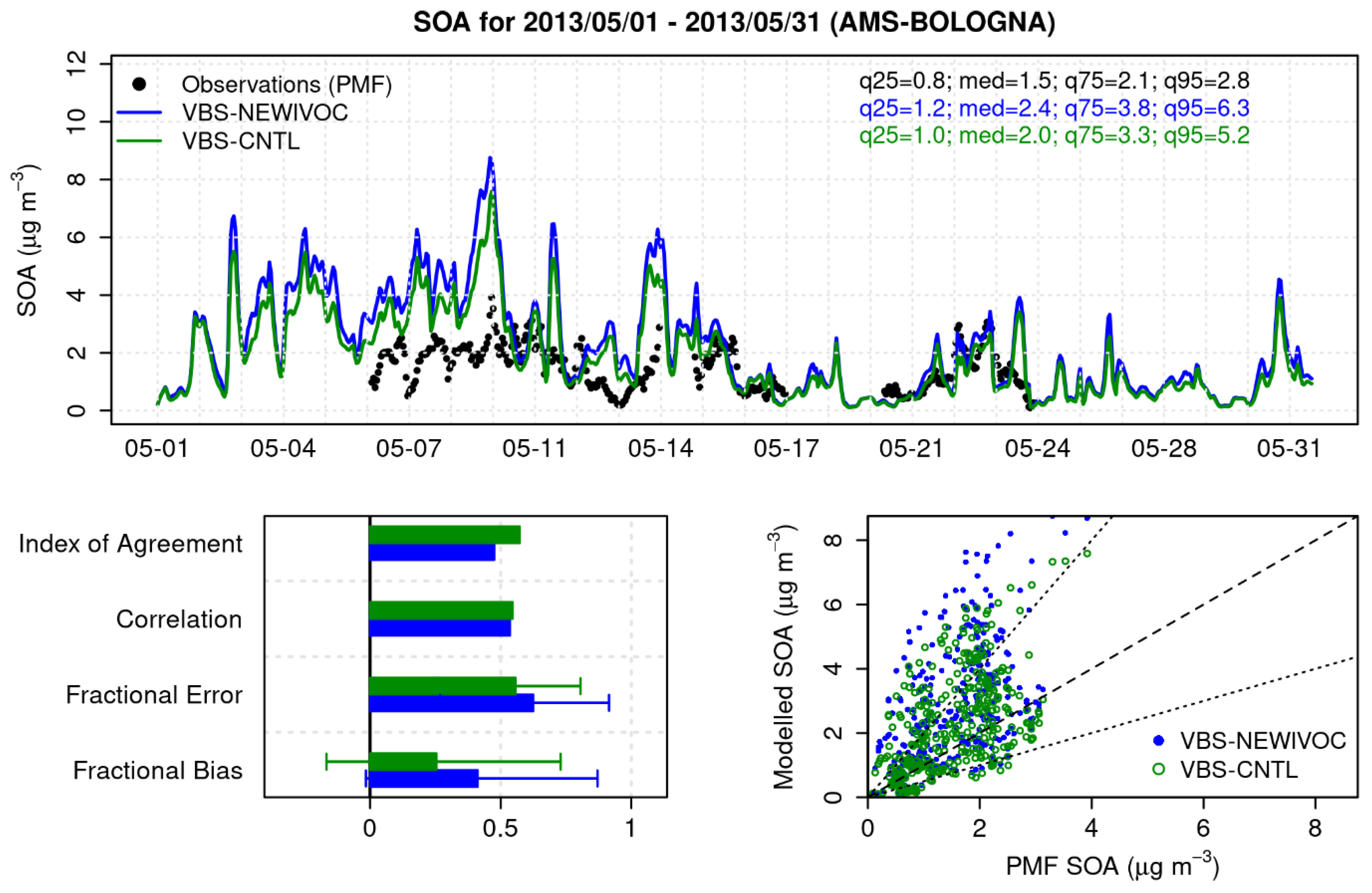

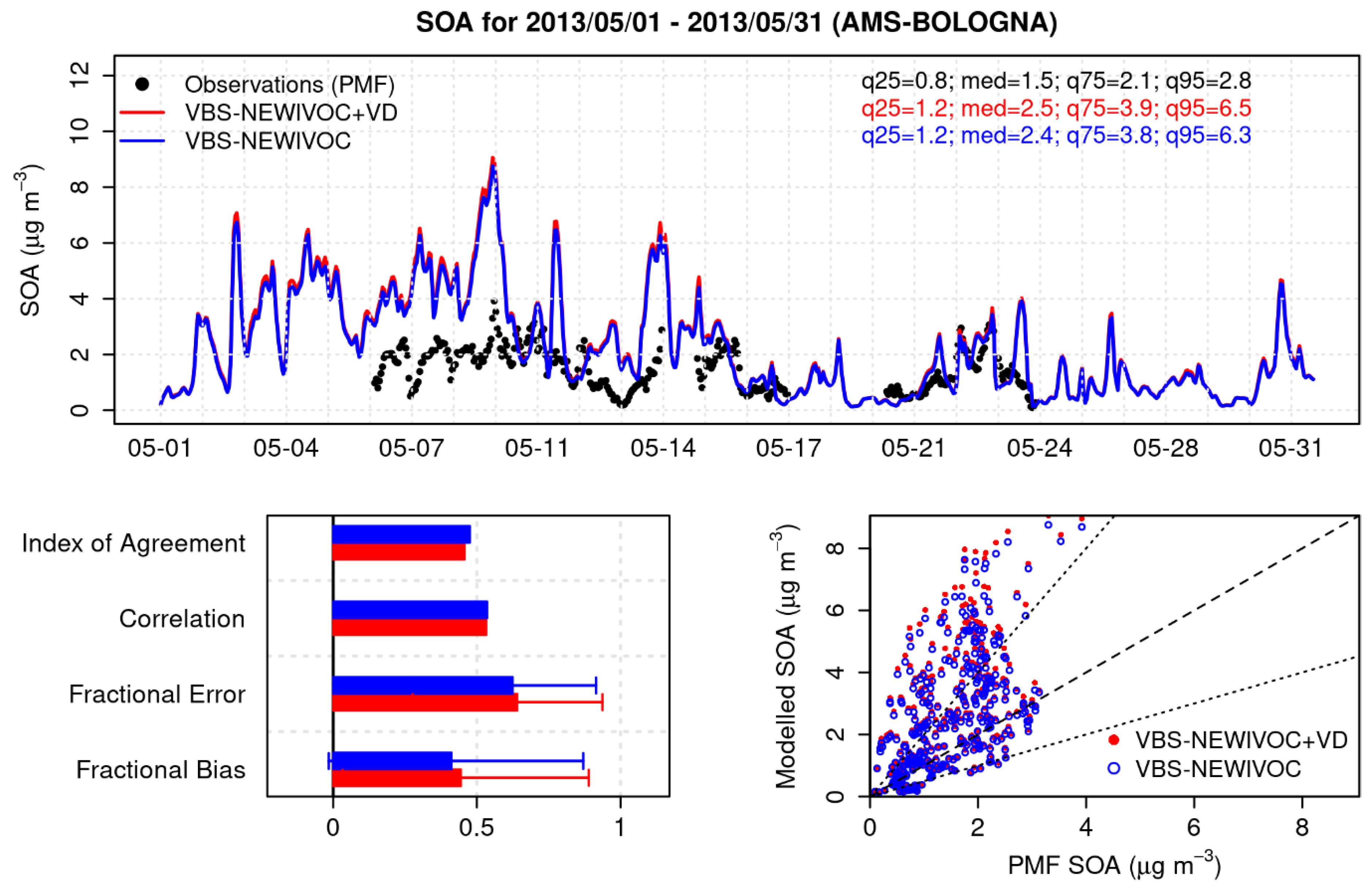
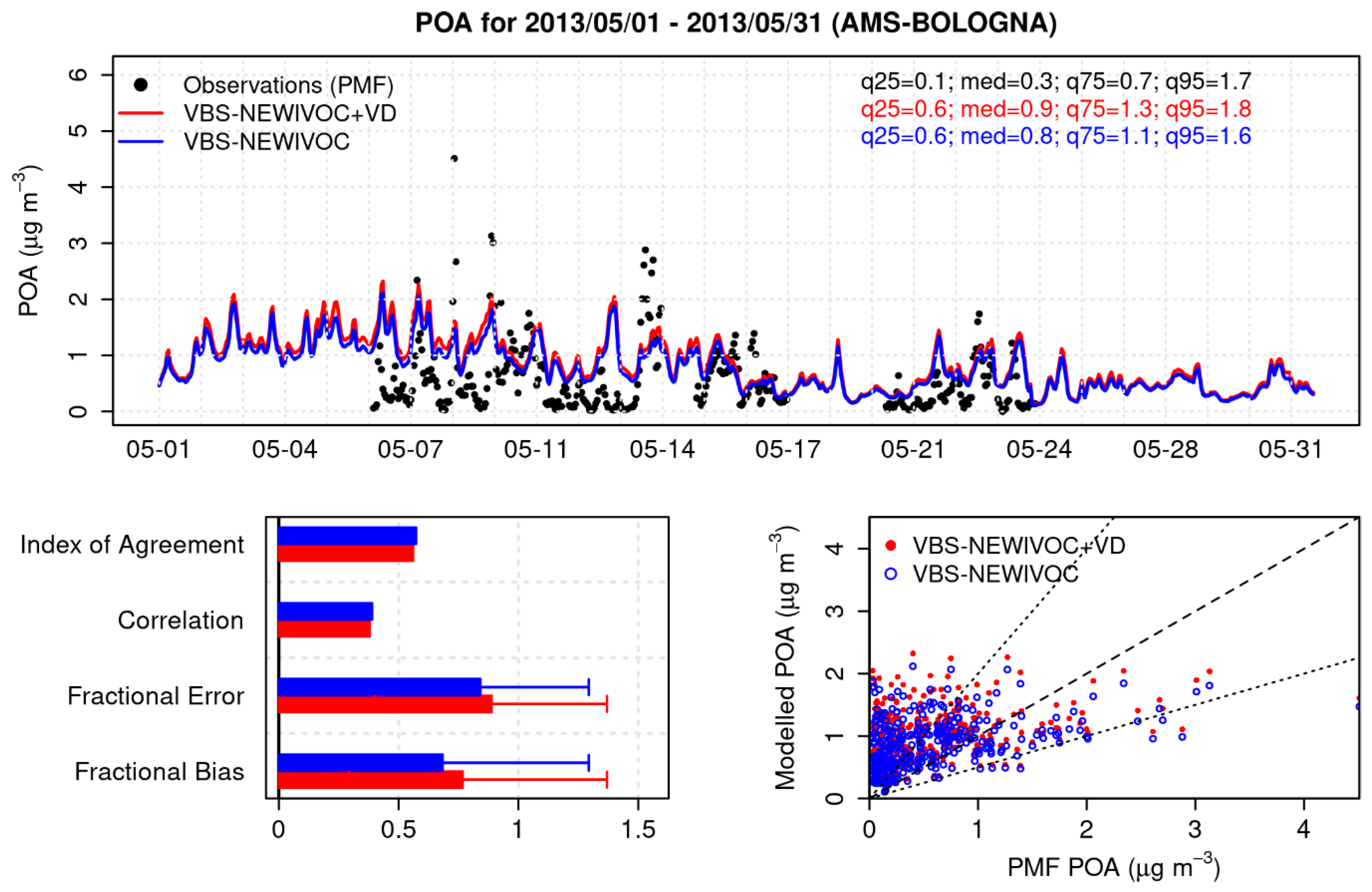


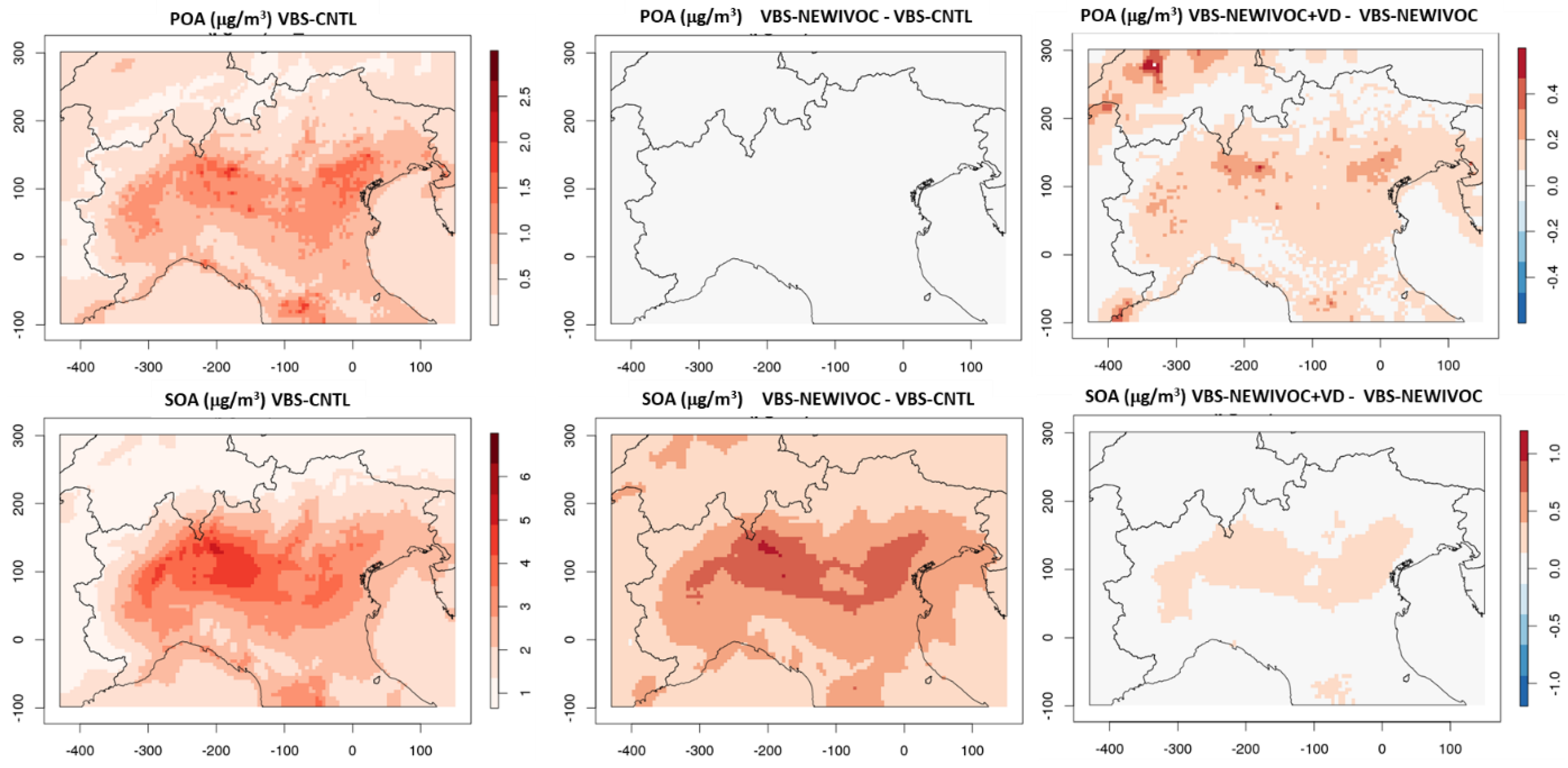
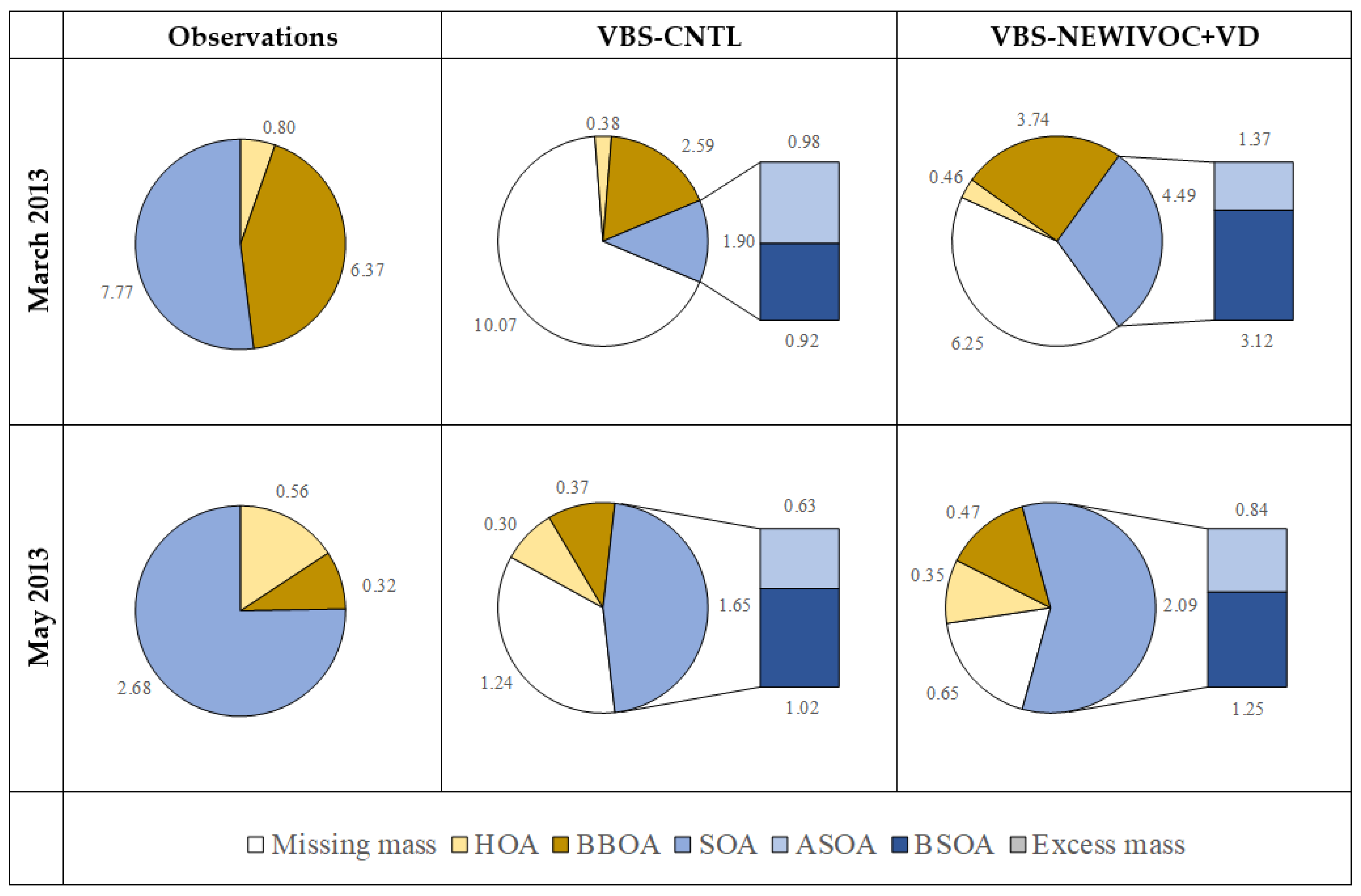

| Simulation Label | OA Scheme | Main Features |
|---|---|---|
| SOAP-CNTL | SOAP | Control SOAP |
| VBS-CNTL | VBS | Control VBS |
| VBS-NEWIVOC | VBS | New parametrizations of IVOC |
| VBS-NEWIVOC+VD | VBS | New parametrizations of IVOC New volatility distributions for POA |
| Period | Simulation | GV | DV | BB | OT | Total |
|---|---|---|---|---|---|---|
| February 2013 | Control | 119.9 | 556.3 | 9461.3 | 462.5 | 10,600.1 |
| IVOC Revised | 276.1 | 3137.2 | 29,960.8 | 462.5 | 33,836.6 | |
| IVOC Revised/Control ratio | 2.30 | 5.64 | 3.17 | 1.00 | 3.19 | |
| May 2013 | Control | 153.2 | 699.9 | 2241.9 | 515.9 | 3611.0 |
| IVOC Revised | 353.8 | 4011.0 | 7099.5 | 515.9 | 11,980.1 | |
| IVOC Revised/Control ratio | 2.31 | 5.73 | 3.17 | 1.00 | 3.32 |
| Period | Simulation | GV | DV | BB | Total |
|---|---|---|---|---|---|
| February 2013 | Control | 80.0 | 370.9 | 6307.5 | 6758.4 |
| OMSV Revised | 108.8 | 679.3 | 8452.1 | 9240.2 | |
| Ratio OMSV Revised/Control | 1.36 | 1.83 | 1.34 | 1.37 | |
| May 2013 | Control | 102.2 | 466.6 | 1494.6 | 2063.4 |
| OMSV Revised | 139.5 | 868.6 | 2002.8 | 3010.9 | |
| Ratio OMSV Revised/Control | 1.37 | 1.86 | 1.34 | 1.45 |
Publisher’s Note: MDPI stays neutral with regard to jurisdictional claims in published maps and institutional affiliations. |
© 2022 by the authors. Licensee MDPI, Basel, Switzerland. This article is an open access article distributed under the terms and conditions of the Creative Commons Attribution (CC BY) license (https://creativecommons.org/licenses/by/4.0/).
Share and Cite
Basla, B.; Agresti, V.; Balzarini, A.; Giani, P.; Pirovano, G.; Gilardoni, S.; Paglione, M.; Colombi, C.; Belis, C.A.; Poluzzi, V.; et al. Simulations of Organic Aerosol with CAMx over the Po Valley during the Summer Season. Atmosphere 2022, 13, 1996. https://doi.org/10.3390/atmos13121996
Basla B, Agresti V, Balzarini A, Giani P, Pirovano G, Gilardoni S, Paglione M, Colombi C, Belis CA, Poluzzi V, et al. Simulations of Organic Aerosol with CAMx over the Po Valley during the Summer Season. Atmosphere. 2022; 13(12):1996. https://doi.org/10.3390/atmos13121996
Chicago/Turabian StyleBasla, Barbara, Valentina Agresti, Alessandra Balzarini, Paolo Giani, Guido Pirovano, Stefania Gilardoni, Marco Paglione, Cristina Colombi, Claudio A. Belis, Vanes Poluzzi, and et al. 2022. "Simulations of Organic Aerosol with CAMx over the Po Valley during the Summer Season" Atmosphere 13, no. 12: 1996. https://doi.org/10.3390/atmos13121996
APA StyleBasla, B., Agresti, V., Balzarini, A., Giani, P., Pirovano, G., Gilardoni, S., Paglione, M., Colombi, C., Belis, C. A., Poluzzi, V., Scotto, F., & Lonati, G. (2022). Simulations of Organic Aerosol with CAMx over the Po Valley during the Summer Season. Atmosphere, 13(12), 1996. https://doi.org/10.3390/atmos13121996





